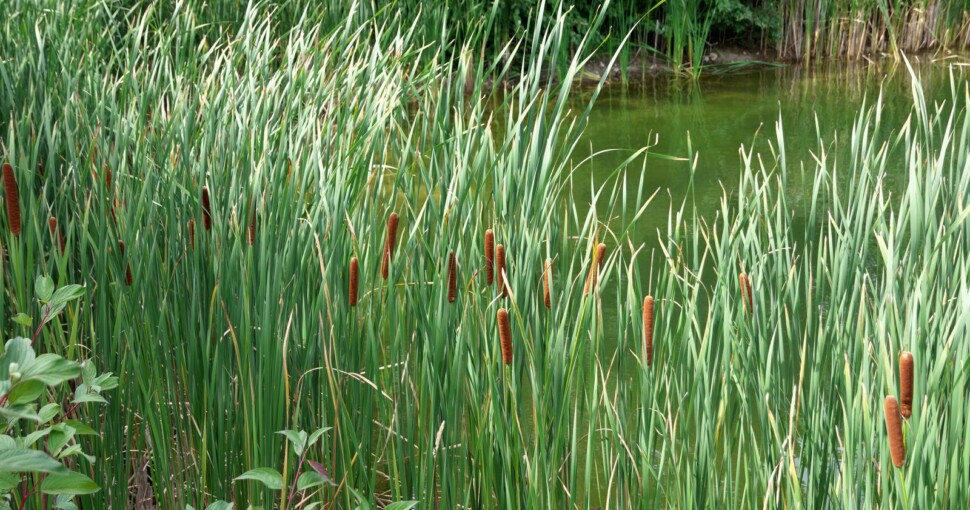Cattails are plants with many names and countless uses. They can be used for stuffing pillows, jackets, and moccasins. The stems may be used to build shelters and furniture and to make hats, mats, and baskets. Cattails have numerous medical uses and can serve as food for people and animals.
Cattails are from the genus Typha and the family Typhaceae. There are thirty different Typha species. They are known by many names; bulrush, reed mace, punks, cumbungi and raupo. Cattails grow naturally in the Northern Hemisphere, where they inhabit the edges of rivers, lakes, and wetlands.
Cattails are popular with gardeners who want to incorporate a pond or bog. They are eye-catching plants that provide height and texture to the architectural design of a garden. Cattails are useful plants that prevent shore erosion and filter toxins from the water. Their roots fix nitrogen, making them beneficial to other plants.
Related: Are Cattails Poisonous?
Cattails can be grown in full or partial sun. They need constant moisture, so they should receive supplemental watering in dry months. Clay is an ideal growing medium for cattails due to its ability to retain moisture. Cattails can grow from two to six feet tall and spread rapidly.
Their spread can be controlled by planting them in pots and removing flowers before they seed. Flowers have two phases. In the first, they look like a tan hot dog bun. In the second, the seed matures into white fluffy clouds looking like cotton candy.
1. Pampas Grass
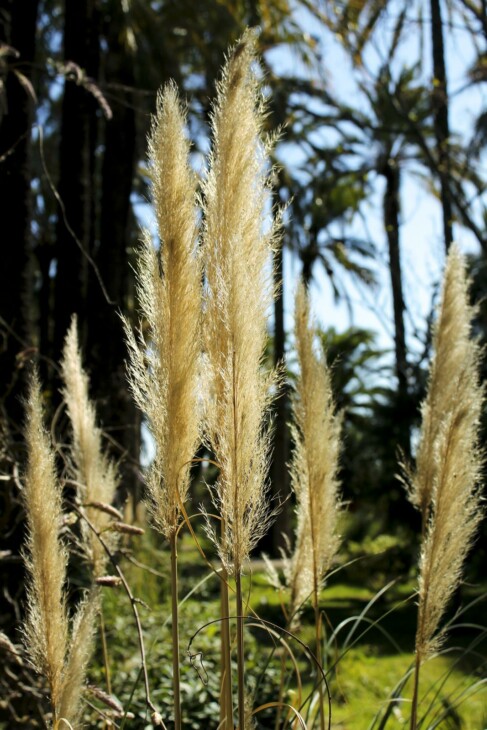
Pampas grass (Cortaderia selloana) belongs to the family Poaceae and grows naturally in South America. It has spread throughout the world and is an invasive species in some countries. It is a fast-growing plant that grows in large clumps and is especially prone to growing on disturbed soil, such as the sides of roads and riverbanks.
Pampas grass looks like second-phase cattail flowers when the seed fluff is present. Pampas grass has large off-white feathery seed tufts that grow on spikes from grass-like green foliage. Different cultivars have varying color seed plumes. Some are silvery white, and others are pink or mauve.
A distinctive feature of pampas grass is the razor-sharp edges of the leaves. Pampas grass leaves have injured many unwary people, birds, and wildlife. Pampas grass, with its feathery seed tufts, poses a significant fire risk in areas vulnerable to bushfires.
Pampas grass grows from five to ten feet tall and six to eight feet wide. It grows in full sun and partial shade in well-draining soil. Pampas grass is drought and wind tolerant and can survive in high saline areas, making it popular along coastal areas.
2. Chenille
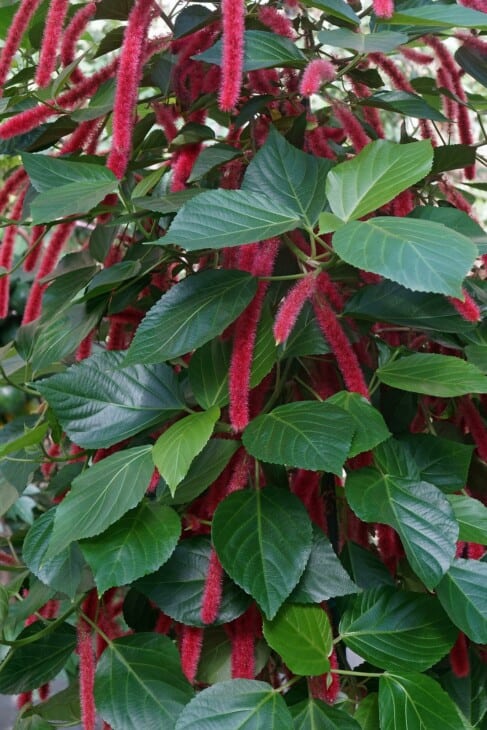
Chenille (Acalypha hispida) is known by many other names; Red Hot Cattail, Philippine Medusa, Foxtail, Catkins, and Monkey Tail. The name Chenille comes from the flowers, which look like pieces of chenille yarn. It is a tropical perennial plant from the family Euphorbiaceae, which originates in the South Pacific.
Chenille is a large evergreen plant that grows up to fifteen feet tall and eight feet wide in ideal conditions. The leaves are bright green and heart-shaped with toothed edges. Chenille plants produce female and male flowers on different plants.
The female flowers are usually red and hang down. Some cultivars have white or creamy flowers. The female flowers, known as catkins, are similar to cattails, except they are red. The flowers can grow up to eighteen inches, making a bold show in a garden.
Chenille is best grown in a warm, moist climate. It thrives in full sunlight or in a partially shaded site but is fussy about water. The plant’s growing medium needs to stay moist but not wet. Water on the flowers causes diseases, so the plant should only be watered from the bottom. It is not cold-tolerant but can survive winter with protection. Some gardeners prefer to treat it as an annual.
3. Sweet Flag
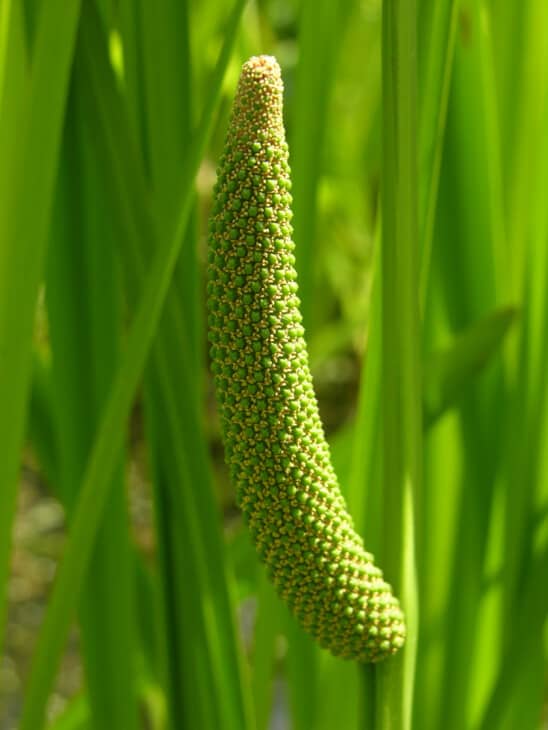
Sweet flag (Acorus calamus) is also known as calamus, muskrat root, myrtle flag, sweet grass, sweet cinnamon, or sway and belongs to the family Acoraceae. It is an herbaceous perennial that can grow to over six feet tall. It is native to central and southern Asia, Russia, Europe, parts of Africa, and North America.
Like cattails, it grows along the edges of waterways, marshes, and wetlands. It has leaves that resemble an iris leaf, except that the edges are crimped and wavy. The leaves are aromatic with a sweet fragrance that increases when crushed.
Sweet flag plants only develop flowers when they grow in water. If they grow on dry land, they will not have flowers. The flowers form on long triangular stems that end in a circular spadix. The spadix is two to four inches long and is covered by small greenish-yellow flowers. The fragrant flowers have six petals each and resemble cattail flowers.
Sweet flags are hardy, semi-evergreen plants that grow anywhere with sufficient water and full sun. They produce berries but reproduce mostly through the spread of their rhizomes. The rhizomes have a sweet cinnamon smell when crushed.
4. Flag Iris
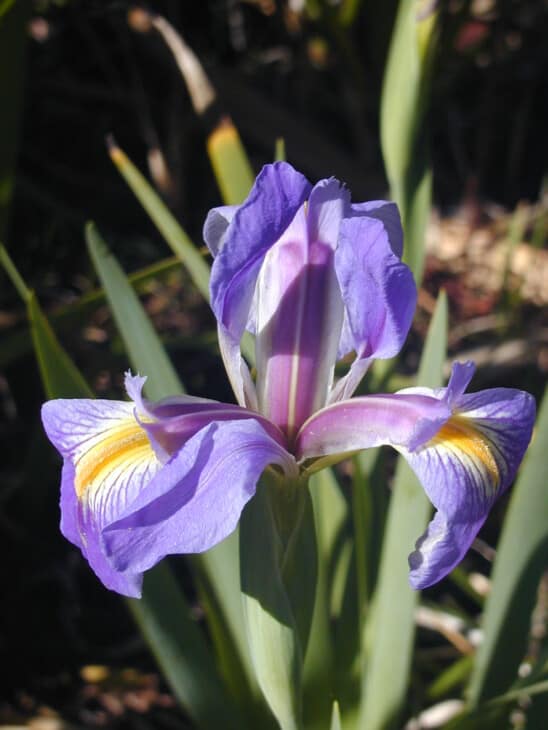
Blue and yellow flag irises are plants with foliage very similar to cattails. Their leaves are narrow and shaped like a sword with a prominent middle vein. Blue flag iris is scientifically known as Iris versicolor, and yellow flag iris is Iris pseudocorus or false Acorus.
Blue flag iris is also called poison flag, purple iris, and large blue flag. It is native to North America and Canada. Yellow flag iris is sometimes named water flag. It grows naturally in Europe, North Africa, and Western Asia. Blue and yellow flag iris belong to the family Iridaceae.
Blue and yellow flag irises have intense green erect foliage, but they differ in the color of their flowers. Blue flag iris has an intense blue to almost purple flower, and yellow flag iris has a bright sunshine-hued blossom.
Flag irises are herbaceous perennials that prefer to grow on the edges of rivers, lakes, ponds, and wetlands. Clay soil is an ideal growing medium for them. Flag irises may be grown in drier areas, but they will require diligent watering to allow them to flourish.
Flag irises have rhizomes that allow them to survive drier periods. The iris will often die back if the weather is hot and dry for extended periods. Once there is sufficient water, the plant will be rejuvenated. Irises reproduce from rhizomes and seeds. They are commonly seen growing alongside cattails.
5. Fountain Grass
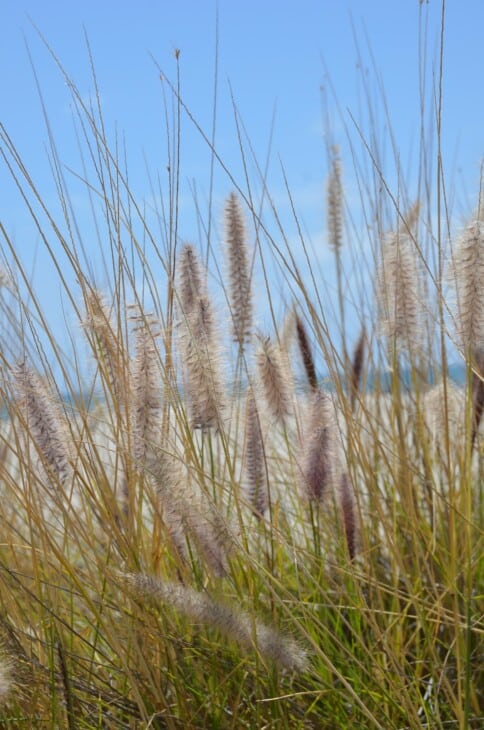
Fountain grasses (Pennisetum alopecuroides) are graceful ornamental plants that add color and texture to a garden. They are similar to cattails, with their prominent flowers resembling the cattail flowers. Fountain grasses are native to Australia, Japan, and China. They have become popular with gardeners worldwide.
Fountain grass leaves grow upright initially. As the plant matures and the leaves grow longer, they bow over gracefully, looking like a fountain. The foliage is usually between twelve to forty-eight inches tall and changes color with the season. It may start green and become a golden or russet color in fall, fading to delicate ivory in winter.
Fountain grass develops long flower spikes. There are many cultivars with different colored flowers. The flowers may be brown, gold, burgundy, white, or black. Fountain grass is best suited to areas in full sun and grows in most soil types except clay. Soils should have good drainage, or rot could set in.
Fountain grass produces abundant seeds, but the seeds seldom germinate in colder climates. Fountain grass is a hardy perennial plant that is a worthwhile addition to the garden.

